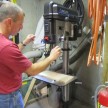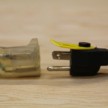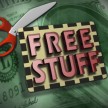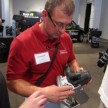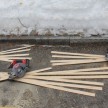Circular Saw Safety
Circular Saw Safety – Preventing Kickback
The American Society for Surgery of the Hand (ASSH) recommends that individuals take the proper precautions to prevent hand-related injuries.
Each year, thousands of people suffer maiming or amputations of their fingers or hands due to improper handling of power saws.
Saw Injuries
In a 2001 study, the Consumer Product Safety Commission (CPSC) found that over 50,000 people were treated in U.S. hospital emergency rooms for injuries associated with table saws, band saws, miter saws, or redial arm saws in the calendar year. Contact with the saw blade was the major hazard to power saw operators, followed by being hit by stock or cutting material.
Circular Saw Safety
To prevent hand injuries, follow these safety tips when using a circular saw:
- Never look away from your work.
- Never use your hands to clear the scraps from a sawing worktable, instead, use a long stick.
- Do not wear loose clothing or jewelry around the wrists.
- Keep your finger off the trigger when carrying a portable power saw.
- Use the correct blade for the application.
- Use sharp blades. Dull blades cause binding, stalling and possible kickback.
- When starting, let the saw reach full speed before cutting and support the work firmly so it will not shift.
- If the saw stalls, switch off the power and unplug the tool before trying to restart it.
- When working with metal, secure the metal materials with clamps or in a machinist’s vise to keep it from moving.
- Check for proper blade guard operation before each cut.
- When starting or stopping the saw, make sure the work is not touching the blade.
- Lower a table saw blade below the table top when finished.
- Keep a clear head, concentrate, and DO NOT DRINK ALCOHOL before using a power saw!
Preventing Kickback:
Kickback is a sudden reaction to a pinched, bound or misaligned saw blade, causing an uncontrolled saw to lift up and out of the workpiece toward the operator. When the blade is pinched or bound tightly by the kerf closing down, the blade stalls and the motor reaction drives the unit rapidly back toward the operator.
If the blade becomes twisted or misaligned in the cut, the teeth at the back edge of the blade can dig into the top surface of the wood causing the blade to climb out of the kerf and jump back toward the operator.
Kickback is the result of tool misuse and/or incorrect operating procedures or conditions and can be avoided by taking proper precautions as given below:
1. Maintain a firm grip with both hands on the saw and position your arms to resist kickback forces.
2. Position your body to either side of the blade, but not in line with the blade.
3. Never place your hand behind the saw blade. Kickback could cause the saw to jump backwards over your hand.
Kickback could cause the saw to jump backwards, but kickback forces can be controlled by the operator, if proper precautions are taken.
1. When blade is binding, or when interrupting a cut for any reason, release the trigger and hold the saw motionless in the material until the blade comes to a complete stop.
2. Never attempt to remove the saw from the work or pull the saw backward while the blade is in motion or kickback may occur.
3. Investigate and take corrective action to eliminate the cause of blade binding.
4. When restarting a saw in a workpiece, center the saw blade in the kerf and check that saw teeth are not engaged into the material.
5. Support large panels to minimize the risk of blade pinching and kickback. Large panels tend to sag under their own weight. Supports must be placed under the panel on both sides, near the line of cut and near the edge of the panel.
6. Do not use dull or damaged blades.
7. Unsharpened or improperly set blades produce narrow kerf causing excessive friction, blade binding and kickback.
8. Blade depth and bevel adjusting locking levers must be tight and secure before making cut.
9. If blade adjustment shifts while cutting, it may cause binding and kickback.
10. Use extra caution when making a “Plunge Cut” into existing walls or other blind areas.
11. Too much blade exposure increases the likelihood of the blade twisting in the kerf and increases the surface area of the blade available for pinching that leads to kickback.
12. Lower guard function Check lower guard for proper closing before each use. Do not operate saw if lower guard does not move freely and close instantly. Never lamp or tie the lower guard into the open position.
13. If saw is accidentally dropped, lower guard may be bent. Raise the lower guard only with the lower guard lift lever and make sure it moves freely and does not touch the blade or any other part, in all angles and depths of cut.
14. Check the operation of the lower guard spring. If the guard and the spring are not operating properly, they must be serviced before use. Lower guard may operate sluggishly due to damaged parts, gummy deposits, or a buildup of debris. Lower guard should be retracted manually only for special cuts such as “Plunge Cuts” and “Compound Cuts”. Raise lower guard by lower guard lift lever and as soon as blade enters the material, lower guard must be released. For all other sawing, the lower guard should operate automatically.
15. Always observe that the lower guard is covering the blade before placing saw down on bench or floor. An unprotected, coasting blade will cause the saw to walk backwards, cutting whatever is in its path. Be aware of the time it takes for the blade to stop after switch is released.
16. Do not run the tool while carrying it at your side. Lower guard may be opened by a contact with your clothing.
17. Periodically remove the blade, clean the upper, lower guards and the hub area with kerosene and wipe it dry, or blow it clean with compressed air. Preventive maintenance and properly operating guard will reduce the probability of an accident.




